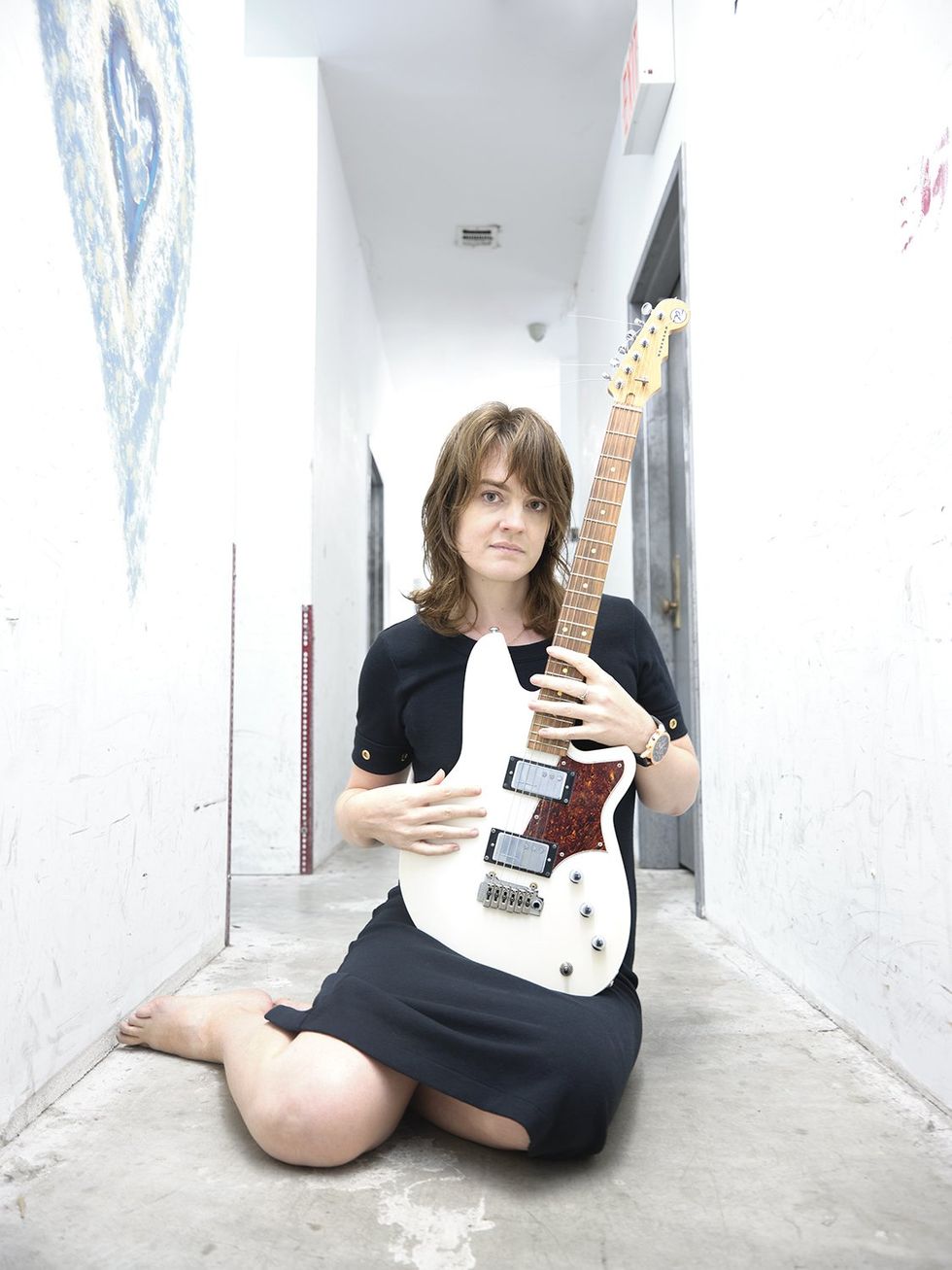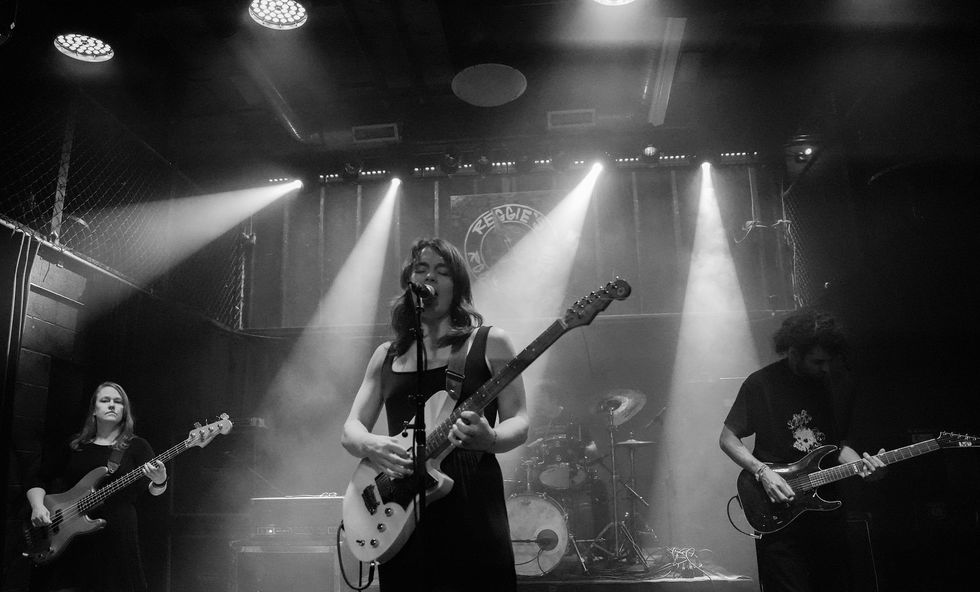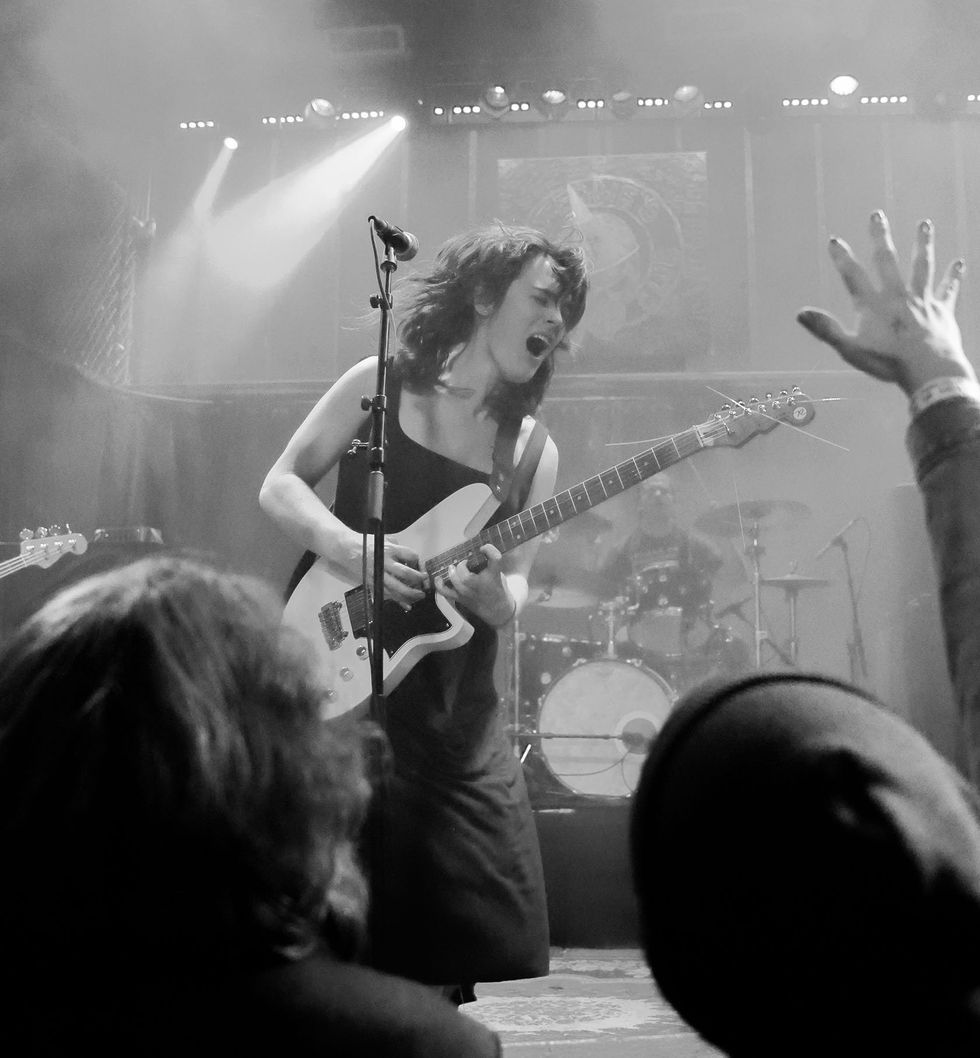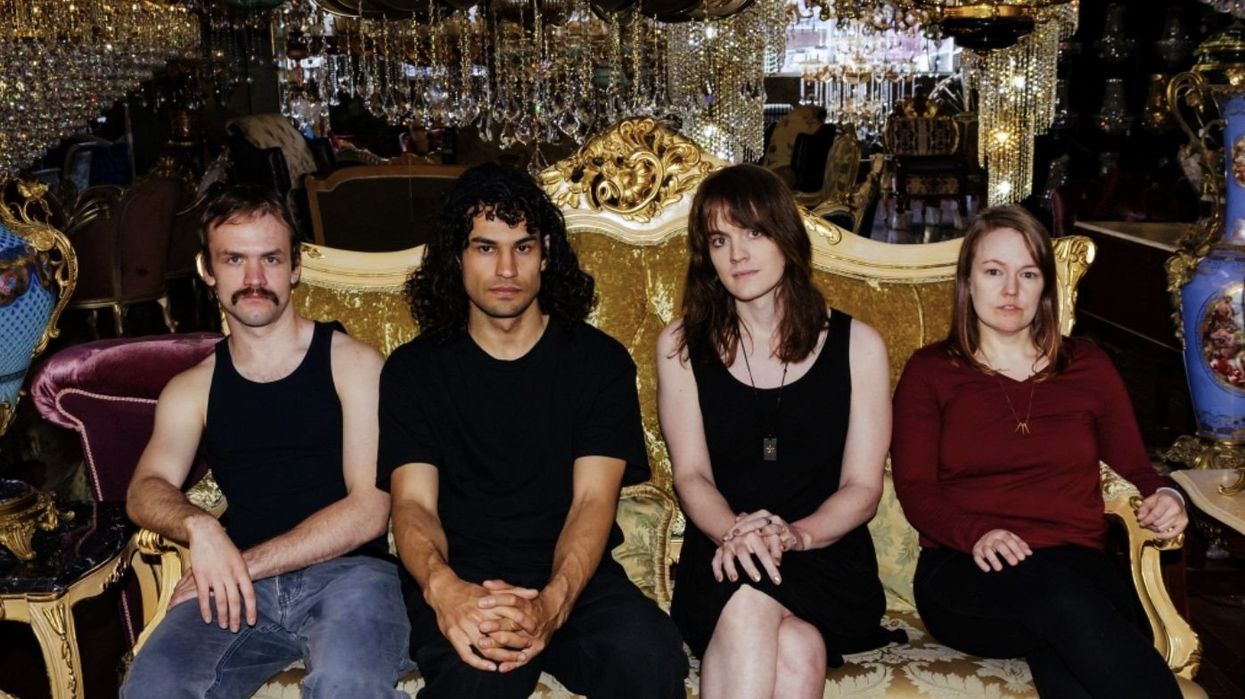Most musicians hate labeling themselves with a genre. But Liturgy vocalist, guitarist, and mastermind Haela Ravenna Hunt-Hendrix is different. She knows exactly what her music sounds like, and why.
“A lot of people don’t like the idea of naming what they do, but I love it,” she says with a laugh. “[Liturgy is] a cross between extreme metal; avant-garde, minimalist, classical music; 19th-century Romantic classical music; and American screamo-inflected metalcore.” Her quick response and detailed description are typical of Hunt-Hendrix’s musical personality. Everything she does comes from a crystallized vision, years of music education, and a passion for the theological and philosophical purpose that she believes animates the greater zoetic universe.
Conceived around the concept of Christianity’s kingdom of heaven, Liturgy’s latest release, 93696—named after a numerological representation of heaven, or a new eon for civilization—and its companion EP, As the Blood of God Bursts the Veins of Time, embrace the entirety of the band’s catalog and push it even further into the cosmos. With each release, Hunt-Hendrix has searched for new inspiration, new sounds, and a new approach. In the past, that included everything from electronic trap-style layers to a wide range of world and orchestral instruments. Based on her earlier musical education, Hunt-Hendrix took a more classical approach to 93696, and while that may have turned off a few black metal purists, she knew what she was doing—and chose to double down on it.
Djennaration
“With this one, I felt happy with the language of the band and wanted to make something really, really epic using that language,” she explains. “It feels like a synthesis of a lot of things that we’ve done before. It’s by far the most ambitious record we’ve ever done. It’s longer, and more complex.” Every instrument, whether in the gigantic “Djennaration” or the instrumental, organ-driven “Angel of Individuation,” plays a key role in a bed of twisting, layered melodies and deep harmonic complexity. This is especially evident in the bass work, where alternate chord inversions and counterpoint are more common than driving root notes.
“[93696] feels like a synthesis of a lot of things that we’ve done before. It’s by far the most ambitious record we’ve ever done.”
“That’s pretty unusual on electric bass,” she admits. “It’s in that classical tradition of writing music. The bass has a role while the higher voices come together doing different things. Then it all coalesces into unity.”
Speaking on the evolution of her musical influences, she elaborates, “I played piano from a very young age and was really into classical music. But, in high school, black metal was this fascinating, faraway thing. I was listening to a lot of the classic second-wave Norwegian stuff. Emperor and Darkthrone were my favorite bands, and I was intentionally emulating them.”
Haela Ravenna Hunt-Hendrix's Gear

From a young age, Hunt-Hendrix was interested in classical music, but in high school, she got into listening to black metal bands like Emperor and Darkthrone.
Photo by Alexander Perelli
Guitars
- Reverend Descent Baritone (standard or drop-D tuning)
Amps
- Sovtek Mig 100
- Orange TH30 combo (studio only)
- Ampeg 4x12 cabinet
Strings & Picks
- Ernie Ball .009s
- Dunlop Tortex .5 mm
After graduating, Hunt-Hendrix attended the prestigious Columbia University, where black metal took a backseat to her philosophy and classical composition studies. Her plan was to make a future in the classical arts. That didn’t last long. “There was a time when I thought I might be a composer and write music in the classical tradition. I studied classical composition and was really into minimalism and Romanticism. I was reading scores and studying them and then trying to write [my own]. But I got swept up in the punk and metal scenes and wanted to, instead, take those techniques and put them into rock music.”
When Hunt-Hendrix says “rock music,” again, think “black metal.” And her alchemy of the genre, as well as classical composition and philosophical studies, would soon manifest in Liturgy’s 2009 debut LP Renihilation, released when the band was just a solo project. Full of blast beats, dissonance, and throat-shredding vocals, there was no question where Hunt-Hendrix cut her teeth. But, even on her early releases, Liturgy went far beyond the aggression and atmosphere of black metal’s forebears. Throughout their catalog, each savage and unrelenting instrument together weaves a whole much larger than their individual parts.
“I studied classical composition and was really into minimalism and Romanticism…. But I got swept up in the punk and metal scenes and wanted to, instead, take those techniques and put them into rock music.”
This, Hunt-Hendrix says, is where the classical influence comes in. “Learning to write music in Western notation and think about it in terms of themes, variations, sonatas, or a fugue has been a big influence on the way that I write Liturgy’s music. I’m combining classical music and metal. Not to overlay symphonic stuff onto metal, but to use the structural tools of symphonic music with metal instruments.”

Hunt-Hendrix composes Liturgy’s songs using DAWs and notation software, then shares them with her bandmates for them to learn.
Photo by Mike Boyd
For all of the classical influence, Hunt-Hendrix’s black-metal-approved wall of distortion gives each Liturgy release its trademark sound. Much of that comes down to her relentless speed-picking technique that transforms single-note lines into what sounds like a demonic orchestra. “I noticed, [when you’re] picking really fast and have a distorted sound, it kind of sounds similar to violins in a string orchestra,” she says. “So that became my main thing. That’s pretty much what I am almost always doing in Liturgy songs. To me, that’s the string orchestra aspect. It’s in the range of a violin or a soprano singer.”
And when she says “always,” she really means it. When Hunt-Hendrix is playing, her picking hand is flying the whole time. With multiple songs clocking in at over 10 minutes, it makes you wonder how she makes it look so easy. “At this point, it’s not hard at all,” she said. “I barely notice. It’s like the way drummers who play really fast double-kick learn to do it so gently that they can do it forever. But it’s a big problem if I don't have the right picks!”
Her playing style—and picks—have been constants throughout Liturgy’s career. But they may be the only ones. Since her first release, Hunt-Hendrix has expanded the band (now including guitarist Mario Miron, bassist Tia Vincent-Clark, and drummer Leo Didkovsky) to record and perform as a quartet. Hunt-Hendrix’s compositions are ever-evolving the sound of the band and the genre.
“I noticed, [when you’re] picking really fast and have a distorted sound, it kind of sounds similar to violins in a string orchestra.”
But with so much of that aforementioned, variegated musical background swirling around her exacting vision, writing 93696 demanded a different approach than a group of people plugging in and jamming. Instead, she again pulled from her classical training, composing each part individually with the help of technology.
“I wrote most of the music using Logic and Ableton, and used Sibelius for notation software,” says Hunt-Hendrix. “Then it’s different with different songs. I'll either make a demo using a drum machine and recording guitar into my computer, or I’ll make the demo using an organ sound that sounds like the guitars will sound. But there’s a lot of revision and a lot of listening back!
“Then I’ll either give the demo to my bandmates or give them music to read. And we were working through this album during the height of Covid, so a lot of our rehearsals were actually on Zoom in the early part of the year.”
Then there’s all of the other instrumentation throughout the record. Everything from harp to ocarina to glockenspiel to vibraphone play their part on 93696. And, while some artists may whip these auxiliary sounds up with virtual instrument plugins, Hunt-Hendrix wanted to keep a raw, human element.

Hunt-Hendrix’s picking hand almost never stops moving in Liturgy’s live performances. In her rapidfire, distorted guitar lines, she hears orchestral strings.
Photo by Mike Boyd
“It’s mostly all done live,” she reveals. “I have a lot of friends and acquaintances in New York who are in the avant-garde classical scene, or jazz scene, or something like that. So I just called people up. I wrote out the music, gave it to them, and then they came to the studio and played it.”
That human element extended to every element of the album’s recording process, giving it a surprisingly gritty, punk vibe. The secret, according to Hunt-Hendrix, is that “It’s mostly all recorded live.” Aside from the additional instrumentation and occasional electronic elements, the band tracked nearly every tremolo-picked guitar line, chordal bass passage, and exceedingly complex drum performance together and in the same room. “And we tracked the whole record to the tape,” she added.
Furthering Liturgy’s no-nonsense approach is both guitarists’ simple selection of gear. Miron relies on his trusty ESP LTD MH-200 into an MXR Fullbore Metal pedal and Quilter ToneBlock 200 amp head. But Hunt-Hendrix takes a uniquely pragmatic approach to her gear, dictated by her equally singular technique.
“Bringing in the old material has this quality of your life flashing before your eyes…. It adds a purpose to the sense of culmination, or heaven, if you like.”
“So, now, I actually play a baritone guitar, a Reverend Descent. I’m almost always playing at the very top of the neck above the 12th fret,” she explains. “All the chord changes and everything are up there. Since I’m playing at the top of the neck all the time, there’s more space between the frets for my fingers. I string it with normal, .009-gauge guitar strings, and it’s tuned like a standard guitar or drop D."Next in line is her beloved Sovtek Mig 100 amplifier, complemented in the studio with an unlikely combo. “I don’t use any pedals at all,” she explains. “I run my guitar straight into my Mig 100. I like it because it distorts a lot, but it’s not a super crunchy distortion like you hear in a lot of metal. The notes ring out and breathe. And, on a recording, I like to contrast it with my Orange TH30 combo. It’s very small and not good for using live. But if you mic it in the studio, it sounds huge."
This raw, DIY character helps make 93696 a wonderfully challenging listen with endless intrigue. The aggression and themes that propel the 15-minute title track are somehow matched by the mandolin and choir-driven space and beauty of “Immortal Life II.” And, speaking of songs on the album ending in “II,” these are references to Liturgy songs from previous releases. As new compositions inspired by her earlier work, they perfectly sum up Hunt-Hendrix’s vision for the entire record.
“For some reason, while we were working on this record, I began listening to older Liturgy songs. I was fascinated by the potential to go back and take material from those songs and work them out in totally new ways. Bringing in the old material has this quality of your life flashing before your eyes. It’s like surveying Liturgy’s whole career before, or at, the end. It adds a purpose to the sense of culmination, or heaven, if you like.
“I’m not saying that this is the band’s last album. I want to keep making more music that sounds like this. But, and maybe it’s more of a time we live in, it feels like this is the last couple of years that humanity will exist. That may or may not be true, but this is an album for that time. In that sense, it’s the final album [laughs].”YouTube It
Liturgy delivers a thrashing wall of sound in a performance of “Glory Bronze” from their 2011 album Aesthetica at First Unitarian Church, a fitting venue, given the band’s theological influence.























![Rig Rundown: AFI [2025]](https://www.premierguitar.com/media-library/youtube.jpg?id=62064741&width=1245&height=700&quality=70&coordinates=0%2C0%2C0%2C0)




















 Zach loves his Sovtek Mig 60 head, which he plays through a cab he built himself at a pipe-organ shop in Denver. Every glue joint is lined with thin leather for maximum air tightness, and it’s stocked with Celestion G12M Greenback speakers.
Zach loves his Sovtek Mig 60 head, which he plays through a cab he built himself at a pipe-organ shop in Denver. Every glue joint is lined with thin leather for maximum air tightness, and it’s stocked with Celestion G12M Greenback speakers.











